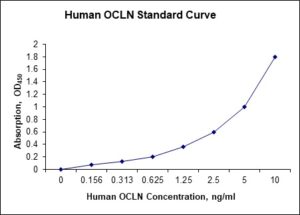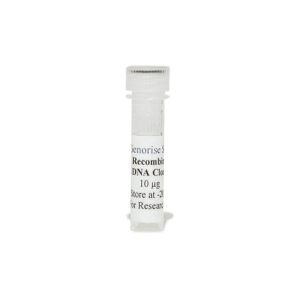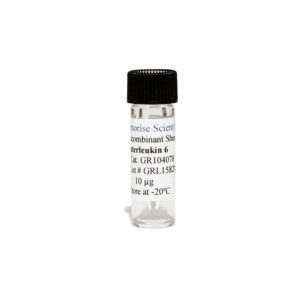Nori Human OCLN ELISA Kit
$461.00 – $832.00
This ELISA kit is for quantification of OCLN in human. This is a quick ELISA assay that reduces time to 50% compared to the conventional method, and the entire assay only takes 3 hours. This assay employs the quantitative sandwich enzyme immunoassay technique and uses biotin-streptavidin chemistry to improve the performance of the assays. An antibody specific for OCLN has been pre-coated onto a microplate. Standards and samples are pipetted into the wells and any OCLN present is bound by the immobilized antibody. After washing away any unbound substances, a detection antibody specific for OCLN is added to the wells. Following wash to remove any unbound antibody reagent, a detection reagent is added. After intensive wash a substrate solution is added to the wells and color develops in proportion to the amount of OCLN bound in the initial step. The color development is stopped, and the intensity of the color is measured.
Alternative names for OCLN: Occludin
This product is for Laboratory Research Use Only not for diagnostic and therapeutic purposes or any other purposes.
- Description
- How Elisa Works
- Product Citation (0)
- Reviews (0)
Description
Nori Human OCLN ELISA Kit Summary
Alternative names for OCLN: Occludin
| Assay Type | Solid Phase Sandwich ELISA |
| Format | 96-well Microplate or 96-Well Strip Microplate |
| Method of Detection | Colorimetric |
| Number of Targets Detected | 1 |
| Target Antigen Accession Number | Q28269 |
| Assay Length | 3 hours |
| Quantitative/Semiquantitative | Quantitative |
| Sample Type | Plasma, Serum, Cell Culture, Urine, Cell/Tissue Lysates, Synovial Fluid, BAL, |
| Recommended Sample Dilution (Plasma/Serum) | No dilution for sample <ULOQ; sufficient dilution for samples >ULOQ |
| Sensitivity | 30 pg/mL |
| Detection Range | 0.156-10 ng/mL |
| Specificity | Human OCLN |
| Cross-Reactivity | < 0.5% cross-reactivity observed with available related molecules, < 50% cross-species reactivity observed with species tested. |
| Interference | No significant interference observed with available related molecules |
| Storage/Stability | 4 ºC for up to 6 months |
| Usage | For Laboratory Research Use Only. Not for diagnostic or therapeutic use. |
| Additional Notes | The kit allows for use in multiple experiments. |
Standard Curve
Kit Components
1. Pre-coated 96-well Microplate
2. Biotinylated Detection Antibody
3. Streptavidin-HRP Conjugate
4. Lyophilized Standards
5. TMB One-Step Substrate
6. Stop Solution
7. 20 x PBS
8. Assay Buffer
Other Materials Required but not Provided:
1. Microplate Reader capable of measuring absorption at 450 nm
2. Log-log graph paper or computer and software for ELISA data analysis
3. Precision pipettes (1-1000 µl)
4. Multi-channel pipettes (300 µl)
5. Distilled or deionized water
Protocol Outline
1. Prepare all reagents, samples and standards as instructed in the datasheet.
2. Add 100 µl of Standard or samples to each well and incubate 1 h at RT.
3. Add 100 µl of Working Detection Antibody to each well and incubate 1 h at RT.
4. Add 100 µl of Working Streptavidin-HRP to each well and incubate 20 min at RT.
5. Add 100 µl of Substrate to each well and incubate 5-30 min at RT.
6. Add 50 µl of Stop Solution to each well and read at 450 nm immediately.
Background:
Occludin (OCLN) is a protein that in humans is encoded by the OCLN gene.[1] Occludin is a 65-kDa integral plasma-membrane protein located at the tight junctions, described for the first time in 1993 by Shoichiro Tsukita.[2] Together with the Claudin group of proteins, it is the main component of the tight junctions. Occludin is important in tight junction stability and barrier function. Studies in which mice were deprived of occludin expression showed morphological stability in several epithelial tissues but also found chronic inflammation and hyperplasia in the gastric epithelium, calcification in the brain, testicular atrophy, loss of cytoplasmic granules in straited duct cells of salivary gland, and thinning of the compact bone. The phenotypical response of these mice to the lack of occludin suggest that the function of occludin is more complex than thought and requires more work.[3] Occludin plays a critical role in maintaining the barrier properties of a tight junction. Thus, mutation or absence of occludin increases epithelial leakiness which is an important barrier in preventing metastasis of cancer. Loss of occludin or abnormal expression of occludin has been shown to cause increased invasion, reduced adhesion and significantly reduced tight junction function in breast cancer tissues. Furthermore, patients with metastatic disease displayed significantly lower levels of occludin suggesting that the loss of occludin and thereby loss of tight junction integrity is important in metastatic development of breast cancer.[4] Occludin also plays an important role in the apoptosis. The C-terminus of occludin is important in receiving and transmitting cell survival signals. In standard cells, loss or disruption of occludin and other tight junction proteins leads to initiation of apoptosis through extrinsic pathways.[5] Studies involving high levels of expression of occludin in cancer cells have shown that occludin mitigates several important cancer proliferation properties. The presence of occludin decreased cellular invasiveness and motility, enhanced cellular sensitivity to apoptogenic factors and lowered tumorigenesis and metastasis of the cancer cells. Specifically, occludin has a strong inhibitory effect on Raf1-induced tumorigenesis. Still, the exact mechanism of how occludin prevents the progression of cancer is not known but it has been shown that cancer progression is linked to the loss of occludin or the silencing of the OCLN gene.[6]
References
- Ando-Akatsuka Y, et al. (1996). J Cell Biol. 133 (1): 43–47.
- Furuse M, et al. (1993). J. Cell Biol. 123 (6 Pt 2): 1777–1788.
- Saitou M, et al. (2000). Molecular Biology of the Cell. 11 (12): 4131–42.
- Martin TA, et al. (2010). International Journal of Molecular Medicine. 26 (5): 723–34.
- Beeman N, et al. (2012). Cell Death & Disease. 3 (2): e273.
- Osanai M, et al. (2006). Cancer Research. 66 (18): 9125–33.
Be the first to review “Nori Human OCLN ELISA Kit”
You must be logged in to post a review.































Reviews
There are no reviews yet.